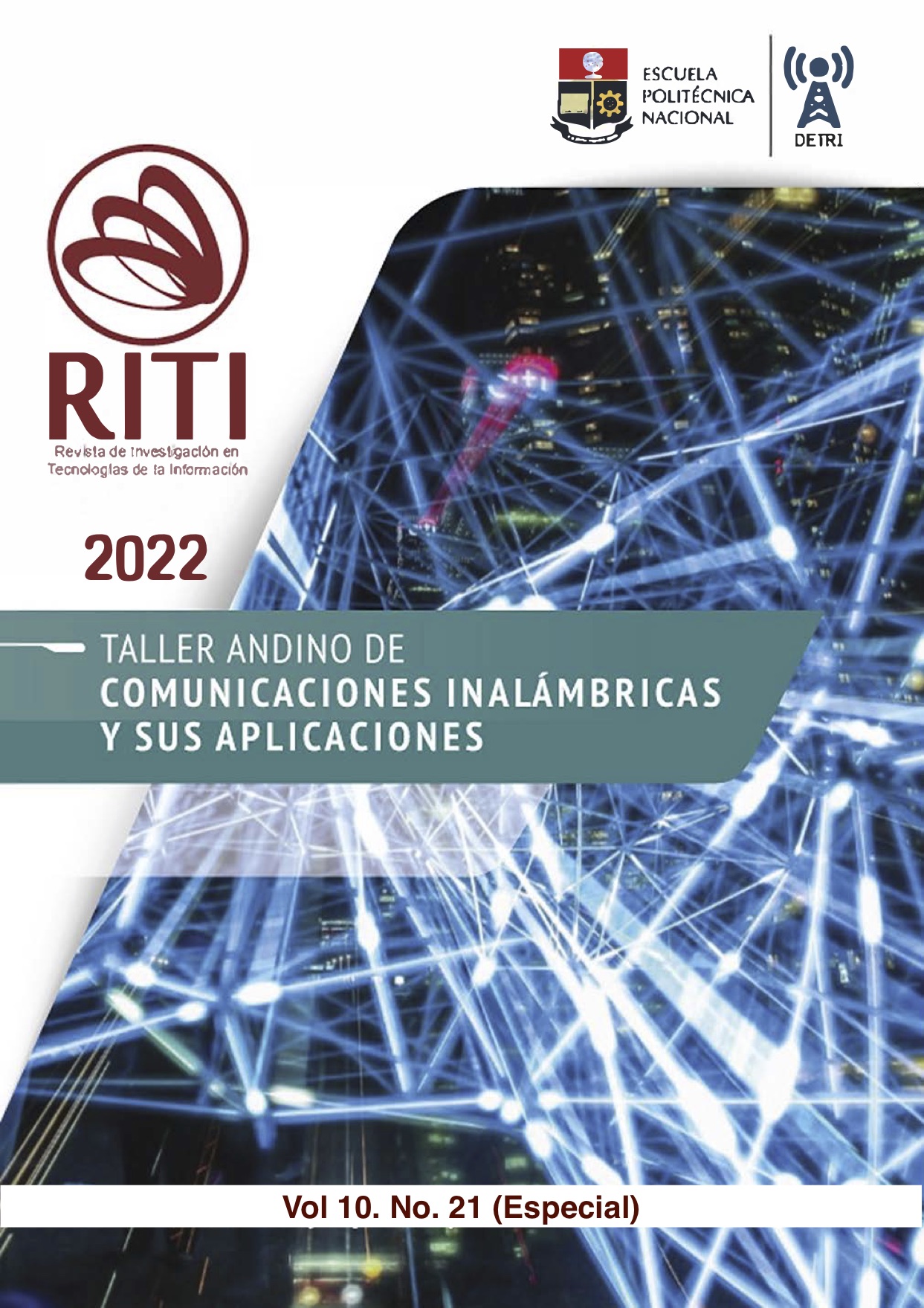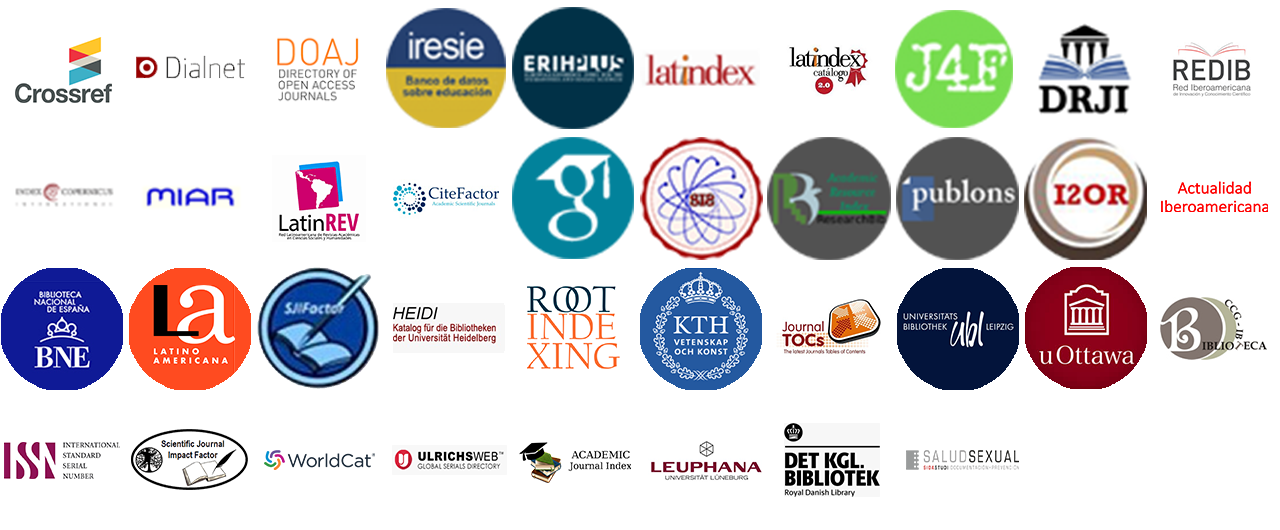Descripción general de comunicaciones habilitadas por UAV en escenarios de emergencia posterior a un desastre
DOI:
https://doi.org/10.36825/RITI.10.21.012Palabras clave:
Vehiculos Aéreos No Tripulados, Comunicaciones de Emergencia, Desastres Naturales, Redes de UAVResumen
Mantener las comunicaciones y brindar servicios a los usuarios son cruciales después de un desastre natural debido al daño de las redes de comunicaciones tradicionales. Las redes de emergencia mediante vehículos aéreos no tripulados (UAVs: Unmanned Aerial Vehicles) resuelven este problema debido a su rápido despliegue y configuración. En este contexto, este artículo presenta una descripción general de los retos y soluciones relacionados con la factibilidad de operación de sistemas de comunicaciones basados en UAVs, incluyendo los desafíos asociados para planificación de la ruta y posicionamiento. En este artículo además se describen las tecnologías para realizar la red principal, así como también las redes implementadas asociados a los UAVs.
Citas
Ruiz, P., Bouvry, P. (2015). Survey on Broadcast Algorithms for Mobile Ad Hoc Networks. ACM Computing Surveys, 48 (1), 1-35. https://doi.org/10.1145/2786005
Ghori, M. R., Zamli, K. Z., Quosthoni, N., Hisyam, M., Montaser, M. (2018). Vehicular ad-hoc network (VANET): Review. IEEE International Conference on Innovative Research and Development (ICIRD), Bangkok, Thailand. https://doi.org/10.1109/ICIRD.2018.8376311
Mukherjee, A., Keshary, V., Pandya, K., Dey, N., Satapathy, S. C. (2018). Flying Ad hoc Networks: A Comprehensive Survey. En S. Satapathy, J. Tavares, V. Bhateja, J. Mohanty (Eds.), Information and Decision Sciences (pp. 569-580). Springer. https://doi.org/10.1007/978-981-10-7563-6_59
Fan, B., Li, Y., Zhang, R., Fu, Q. (2020). Review on the Technological Development and Application of UAV Systems. Chinese Journal of Electronics, 29 (2), 199-207. https://doi.org/10.1049/cje.2019.12.006
Azari, M. M., Rosas, F., Pollin, S. (2019). Cellular Connectivity for UAVs: Network Modeling, Performance Analysis, and Design Guidelines. IEEE Transactions on Wireless Communications, 18 (7), 3366-3381. https://doi.org/10.1109/TWC.2019.2910112
Xiao, Y., Hu, F. (2008). Cognitive Radio Networks. CRC Press.
Zhao, N., Lu, W., Sheng, M., Chen, Y., Tang, J., Yu, F. R., Wong, K. K. (2019). UAV-Assisted Emergency Networks in Disasters. IEEE Wireless Communications, 26 (1), 45-51. https://doi.org/10.1109/MWC.2018.1800160
Zhang, Y., Cheng, W. (2019). Trajectory and Power Optimization for Multi-UAV Enabled Emergency Wireless Communications Networks. IEEE International Conference on Communications Workshops (ICC Workshops), Shanghai, China. https://doi.org/10.1109/ICCW.2019.8756780
Bertsekas, D. P. (2009). Convex Optimization Theory. Athena Scientific. http://web.mit.edu/dimitrib/www/Convex_Theory_Entire_Book.pdf
Yuan, X., Tian, H., Nie, G. (2020). Joint Access and Backhaul Link Optimization in Multiple UAV-Assisted Emergency Network. IEEE/CIC International Conference on Communications in China (ICCC), Chongqing, China. https://doi.org/10.1109/ICCC49849.2020.9238878
Peng, G., Xia, Y., Zhang, X., Bai, L. (2018). UAV-Aided Networks for Emergency Communications in Areas with Unevenly Distributed Users. Journal of Communications and Information Networks, 3 (4), 23-32. https://doi.org/10.1007/s41650-018-0034-1
Sambo, Y. A., Klaine, P. V., Nadas, J. P. B., Imran, M. A. (2019). Energy Minimization UAV Trajectory Design for Delay-Tolerant Emergency Communication. IEEE International Conference on Communications Workshops (ICC Workshops), Shanghai, China. https://doi.org/10.1109/ICCW.2019.8757127
Zhang, X., Zheng, G., Lambotharan, S. (2020). Trajectory Design for UAV-Assisted Emergency Communications: A Transfer Learning Approach. IEEE Global Communications Conference, Taipei, Taiwan. https://doi.org/10.1109/GLOBECOM42002.2020.9348212
Arulkumaran, K., Deisenroth, M. P., Brundage, M., Bharath, A. A. (2017). Deep Reinforcement Learning: A Brief Survey. IEEE Signal Processing Magazine, 34 (6), 26-38. https://doi.org/10.1109/MSP.2017.2743240
Pan, S. J., Yang, Q. (2010). A Survey on Transfer Learning. IEEE Transactions on Knowledge and Data Engineering, 22 (10), 1345-1359. https://doi.org/10.1109/TKDE.2009.191
Steiger, J., Lu, N., Sorour, S. (2020). Learning for Path Planning and Coverage Mapping in UAV-Assisted Emergency Communications. IEEE Global Communications Conference, Taipei, Taiwan. https://doi.org/10.1109/GLOBECOM42002.2020.9322190
Kaur, M., Mohta, A. (2019). A Review of Deep Learning with Recurrent Neural Network. International Conference on Smart Systems and Inventive Technology (ICSSIT), Tirunelveli, India. https://doi.org/10.1109/ICSSIT46314.2019.8987837
Mooney, C. Z. (1997). Monte Carlo Simulation. SAGE.
Dalmasso, I., Galletti, I., Giuliano, R., Mazzenga, F. (2012). WiMAX networks for emergency management based on UAVs. IEEE First AESS European Conference on Satellite Telecommunications (ESTEL), Rome, Italy. https://doi.org/10.1109/ESTEL.2012.6400206
Kaleem, Z., Yousaf, M., Qamar, A., Ahmad, A., Duong, T. Q., Choi, W., Jamalipour, A. (2019). UAV-Empowered Disaster-Resilient Edge Architecture for Delay-Sensitive Communication. IEEE Network, 33 (6), 124-132. https://doi.org/10.1109/MNET.2019.1800431
Hu, F., Hao, Q., Bao, K. (2014). A Survey on Software-Defined Network and OpenFlow: From Concept to Implementation. IEEE Communications Surveys Tutorials, 16 (4), 2181-2206. https://doi.org/10.1109/COMST.2014.2326417
Arafat, M. Y., Moh, S. (2019). Localization and Clustering Based on Swarm Intelligence in UAV Networks for Emergency Communications. IEEE Internet of Things Journal, 6 (5), 8958-8976. https://doi.org/10.1109/JIOT.2019.2925567
Chen, C. Y., Ye, F. (2012). Particle swarm optimization algorithm and its application to clustering analysis. 17th Conference on Electrical Power Distribution, Tehran, Iran. https://ieeexplore.ieee.org/document/6254579
Chakraborty, B. (2002). Genetic algorithm with fuzzy fitness function for feature selection. IEEE International Symposium on Industrial Electronics (ISIE), L'Ayuila, Italy. https://ieeexplore.ieee.org/document/5730782
Liu, M., Yang, J., Gui, G. (2019). DSF-NOMA: UAV-Assisted Emergency Communication Technology in a Heterogeneous Internet of Things. IEEE Internet of Things Journal, 6 (3), 5508-5519. https://doi.org/10.1109/JIOT.2019.2903165
Feng, W., Tang, J., Yu, Y., Song, J., Zhao, N., Chen, G., Wong, K. K., Chambers, J. (2020). UAV-Enabled SWIPT in IoT Networks for Emergency Communications. IEEE Wireless Communications, 27 (5), 140-147. https://doi.org/10.1109/MWC.001.1900656
Zhang, Y., Lu, G., Zhang, J. (2020). Delay and Transmission Rate Analysis of Buffer-Aided UAV Networks for Emergency Communications. International Conference on Wireless Communications and Signal Processing (WCSP), Nanjing, China. https://doi.org/10.1109/WCSP49889.2020.9299820
Huang, K. C., Wang, Z. (2011). Millimeter Wave Communication Systems. John Wiley & Sons.
Bupe, P., Haddad, R., Rios-Gutierrez, F. (2015). Relief and emergency communication network based on an autonomous decentralized UAV clustering network. SoutheastCon, Fort Lauderdale, FL, USA. https://doi.org/10.1109/SECON.2015.7133027
Meier, L., Tanskanen, P., Fraundorfer, F., Pollefeys, M. (2011). PIXHAWK: A system for autonomous flight using onboard computer vision. IEEE International Conference on Robotics and Automation, Shanghai, China. https://doi.org/10.1109/ICRA.2011.5980229
Atoev, S., Kwon, K. R., Lee, S. H., Moon, K. S. (2017). Data analysis of the MAVLink communication protocol. International Conference on Information Science and Communications Technologies (ICISCT), Tashkent, Uzbekistan. https://doi.org/10.1109/ICISCT.2017.8188563
Jara-Olmedo, A., Medina Pazmiño, W., Tozer, T. Aguilar, W. G., Pardo, J. A. (2018). E-services from Emergency Communication Network: Aerial Platform Evaluation. International Conference on eDemocracy & eGovernment (ICEDEG), Ambato, Ecuador. https://doi.org/10.1109/ICEDEG.2018.8372336
Publicado
Cómo citar
Número
Sección
Licencia
Derechos de autor 2022 Revista de Investigación en Tecnologías de la Información

Esta obra está bajo una licencia internacional Creative Commons Atribución-NoComercial-SinDerivadas 4.0.
Esta revista proporciona un acceso abierto a su contenido, basado en el principio de que ofrecer al público un acceso libre a las investigaciones ayuda a un mayor intercambio global del conocimiento.
El texto publicado en la Revista de Investigación en Tecnologías de la Información (RITI) se distribuye bajo la licencia Creative Commons (CC BY-NC
 ), que permite a terceros utilizar lo publicado citando a los autores del trabajo y a RITI, pero sin hacer uso del material con propósitos comerciales.
), que permite a terceros utilizar lo publicado citando a los autores del trabajo y a RITI, pero sin hacer uso del material con propósitos comerciales.



